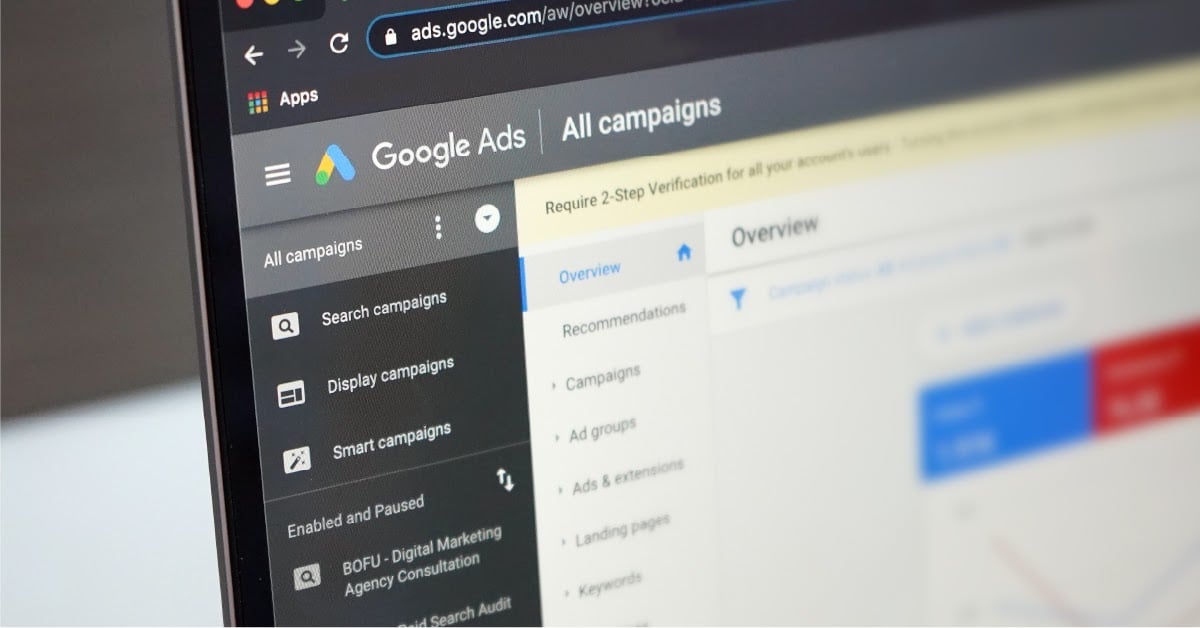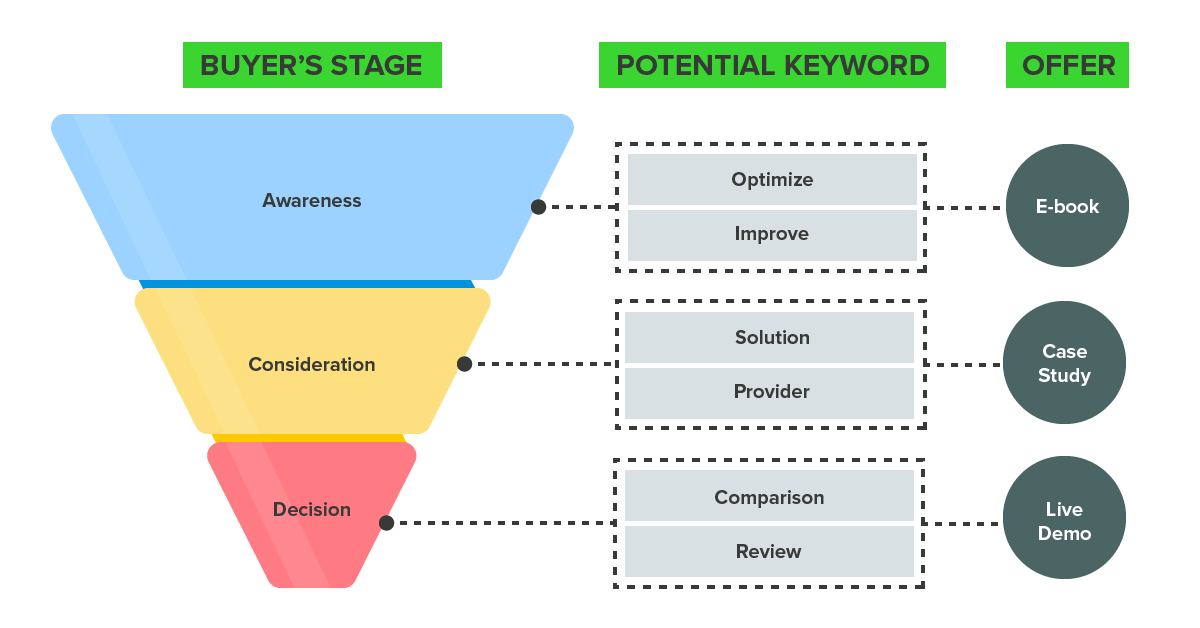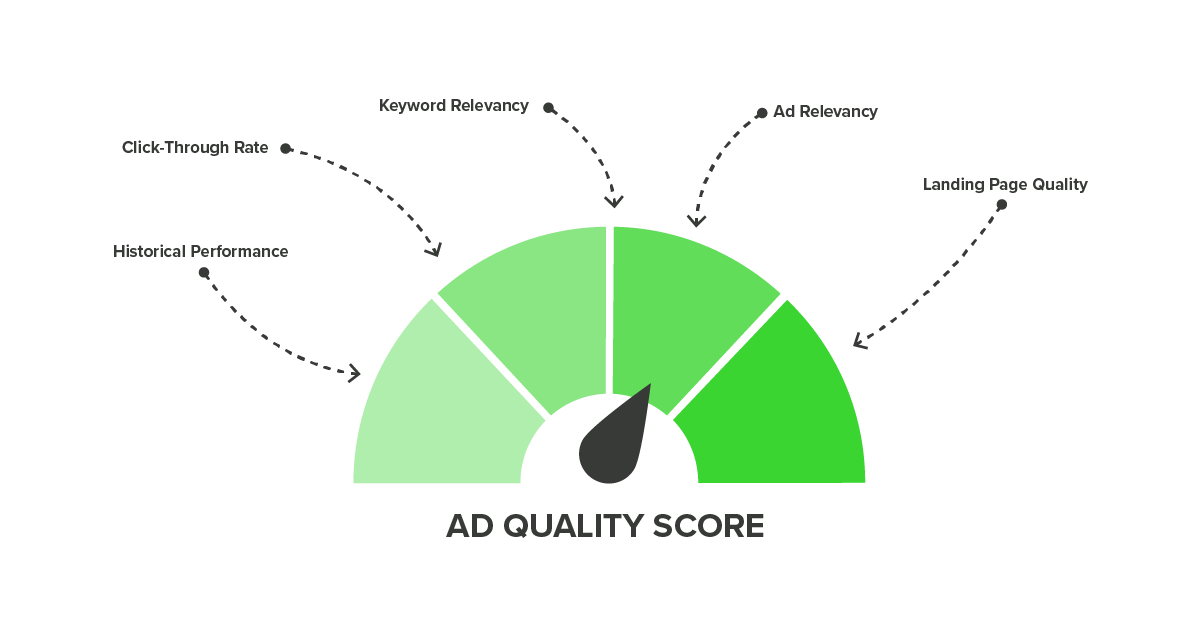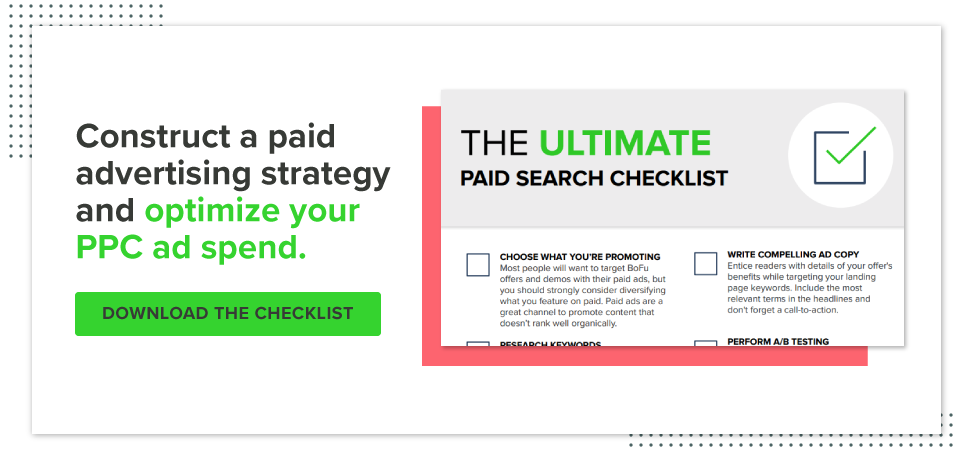
Before you begin optimizing your paid campaigns, you should understand what the guidelines and goals are for your optimization. What is the purpose of your campaign? What type of offer are you promoting? Who are you promoting your offer to?
Once you answer these questions, making optimizations naturally follows. Your changes should be made with your ultimate purpose in mind.
When you optimize your campaigns, concentrating on converting qualified contacts should be your core objective. To complete this objective, there are numerous elements to keep in mind.
Budget, Structure and Searcher Intent
If you’re running paid ads, more than likely you have a budget, so the whole point behind optimizing your campaigns is maximizing the value you generate within that budget. Ultimately, attracting more visitors is great, but that should not be your core focus. The end goal isn’t more sessions — it’s more customers progressing through and closing at the end of your funnel. Making decisions based on this mindset is imperative to success.
Next, ensuring you have a logical set up is extremely useful when optimizing campaigns. A lot of the ways we optimize paid channels here at New Breed directly relate to the structure of the campaigns themselves.
“Every offer I’m promoting is its own campaign, and the more targeted I get with that, the more control I can have over changing the budget,” says Guido Bartolacci, New Breed’s Head of Demand Generation.
Essentially, we build campaigns around the offer being promoted or the keyword topic. By doing that, you can have a close one-to-one relationship with your keyword and campaign structure. Then, landing pages naturally follow.
Basically, the more you narrow your focus, the more ability you will have to manipulate your budget as you recognize the nuances associated with different campaigns, ads and terms.
“If you can get control over every single keyword you’re bidding on or every single ad you’re running to the greatest degree possible, you’re more likely to get more from your budget,” says Guido.
Additionally, “properly matching your terms with the searcher’s intent is key,” says Rider Gordon, Head Search Strategist at New Breed.
As you’re conducting keyword research, you should be keeping an eye on which terms would make the most sense for consumers to be searching at different stages of their buyer’s journey.
You might find some keywords that people would tend to search for when they are seeking awareness about a topic. Many of these terms will take on the form of questions. “What is Demand Generation?” is a great example of this.
Alternatively, you might find terms that are more typical of searchers in their decision stage like “Best HubSpot Agency.”
Rider explains that if you find awareness stage keywords, you should pair them with ToFu offers, and if you find decision stage keywords, you should pair them with BoFu offers. The same system applies for consideration stage keywords and MoFu offers — these are just more difficult to categorize.

He also suggests that experimenting by pairing different keywords with different offers can be wise. For example, he enjoys testing content from multiple funnel stages to see how each piece performs for a given set of keywords.
“If 80% of people are converting on a MOFU ad at the end of the 60 days, I pause the TOFU and BOFU offers and work on optimizing that,” says Rider.
Overall, you can see that budget, structure and searcher intent are at the core of how you need to begin thinking about optimizing your campaigns. By developing a deep understanding of each element, you can make minute adjustments that generate major impacts.
Making Adjustments
One of the most important elements to consider in optimizing your campaigns and ads is the cost per conversion of each keyword. In trying to maximize your conversions within the confines of your budget, this will be the best place to start, as it can help inform many of your decisions.
Pausing keywords
As you search through your terms, try to find keywords that are significantly more expensive than the others.
“If I went in and found an outlier that was costing a lot of money, I’d want to evaluate what my bidding strategy was like on that keyword and potentially pause it entirely,” says Guido.
Essentially, you want to ensure you’re not allowing one term to eat up your entire budget — especially if it’s converting at a low rate. A low-converting, high-cost keyword could be taking away impression opportunities from other terms.
“At this point, I’m considering cost per conversion to be my efficiency metric,” says Guido.
Normally, if a keyword is inefficient, it’s best to evaluate how closely related that term is to the campaign. A higher-volume, less-specific term can often be a culprit. Sometimes opting for more concentrated terms can relieve these issues.
Testing your ads constantly
It’s also wise to conduct the same exercise on the ad level. If you find that one ad has a much higher cost per conversion, you should pause that ad to put more budget towards the others.
On the ad level, we also always advise running at least two ads per ad group. The ads should be very similar to each other with only one detail that’s different between them. In this way, after letting the ad group run for a while, you can determine which individual ad has a higher conversion rate. Then, you can clone the better performing ad and change one detail about it. Even with no major changes being made, you can gradually improve your conversion rates.
It’s best to start with the most noticeable changes, like headlines, and then make smaller changes as you go.
Re-evaluating searcher intent
If pausing your high-cost keyword doesn’t seem like the right move, Rider suggests reconsidering searcher intent and potentially trying to use the term at a different point in the buyer’s journey.
“If I see a keyword like ‘best event management software,’ the person searching that term is probably pretty far along in their buyer’s journey. They should be getting a MoFu competitor comparison or a contact us form with copy on the landing page explaining why they’re the best. That same searcher probably isn’t going to convert on an e-book,” he says.
Switching a keyword to a different offer and stage in the buyer’s journey can dramatically reduce the cost per conversion. One potential indicator that this is the right move could be if a term has a high number of clicks without many conversions.
Lowering a term’s max cost per click
If you identify a keyword that you’re overspending on, another option is trying to lower that term’s max cost per click (CPC).
Your max CPC is the maximum amount you are willing to pay for a click on a specific term. If you are overspending on a term but don’t want to pause it, lowering the max amount you are willing to pay can help you spend less, while still generating visibility for the term. Of course, also keep in mind that if you lower your max CPC too much, your keyword might not be displayed.
Improving quality score
Another consideration when you have a term that you are spending too much budget on is to evaluate the quality score of that term. Really, improving quality score on the keyword or ad level is one of the all-around best optimizations you can make.

Quality score is a metric used to evaluate the quality and relevance of your ads and keywords. Essentially, it is a measure of how much value your ad provides to searchers by judging three elements: ad relevance, landing page experience and expected clickthrough rate.
Quality score is used to calculate your CPC and also, when multiplied by your maximum CPC, helps Google determine where your ad will rank. Essentially, the better your quality score, the less you will need to bid and spend to maintain your current ad position.
Segmenting keywords
If you have an ad with many keywords, it can be difficult to improve the quality score for each of those keywords. This might once again cause you to overspend on clicks for these terms or might cause your ad to slip in auction rankings.
You can solve this problem by segmenting more keywords into their own ad groups. Basically, you can create ads and landing pages focused around a specific term. This will help you to boost the term’s quality score, reduce your spend on a CPC basis and help your ad climb the rankings.
Guido points out that, “Your budget is controlled at the campaign level, so if you want to get more control over that you need to get more campaigns that are single keywords.”
It is worth noting that there is a tradeoff, though. If you were to create unique ads for each of your keywords, you would be able to boost your quality scores and optimize your campaigns, but you would also need to invest much more time to make it happen.
Shifting ad schedule
Another way to optimize your campaigns is by looking into what days and times searchers are converting. You can find this information under the Ad Schedule tab in Google Ads.
Rider says, “Go into each campaign and alter that ad schedule, allocating the budget to the times of day that people are converting.”
He also explains that using good judgement in altering when your ad displays is wise. You don’t want to allocate all budget to after a certain time period if only 65% of your conversions occur during that period. Also, look for substantial trends before making this shift; you don’t want to make unfounded assumptions that hurt your account.
Making changes based on location
You can also adjust your spend based on the location the conversions are coming from. You can do this from the Locations tab in Google Ads.
Rider explains his strategy for location adjustment with an example.
“Basically we’ve got six conversions between country A and country B. Country A has two thirds of those conversions and country B has one third, so I’ll make a bid adjustment. I’ll bump the bid for country A up by two-thirds because we are willing to pay two-thirds more for clicks there. I’ll also bump up Country B by 33%,” he says.
Essentially, if high-fit contacts are converting at higher rates in one region compared to another, you are probably willing to pay more for clicks in those regions. On the other hand, you would probably be less willing to pay for clicks in regions that generated low-fit contacts or had lower conversion rates.
Overall, this kind of optimization isn’t a science, so changes should be carefully considered.
Modifying bids based on devices
Using the Google Ad’s Devices tab, you can also adjust your bidding strategy based on the number of conversions occurring on different devices.
“If I find no conversions coming from mobile devices and tablets, I’ll drop my bids to pay 50% less for clicks coming from those sources. Meanwhile, if all of the conversions are coming from desktop, I’ll pay 50% more for those clicks,” Rider says.
Once again, such budget changes should be carefully considered and based on data.
Building audiences
To narrow the focus of your ads, you can target specific groups based on lists you’ve created in Google Analytics.
For example, you can build a paid campaign targeted at people who have already downloaded one of your offers.
“Sometimes it pays to be highly targeted with your offers. It can help to increase the likelihood that when ads display they’re going to be displayed to someone they’re highly relevant to. This leads to fewer wasted clicks,” says Guido.
Considering demographics
Besides creating lists in Google Analytics, you can also narrow your audience to the highest-fit individuals by leveraging demographics.
Consider whether there are any demographics you are currently targeting that have produced a much higher cost per conversion than the others.
To illustrate, Guido explains a scenario where you are promoting an educational e-book intended for B2B companies and their employees. If you were to look under the Demographics tab in Google Ads and see a large number of people who have clicked on the ad between the ages of 18 and 24, it’s probably best to stop displaying your ad to that demographic. It’s likely that this group is composed of students or low level employees who are currently unable to influence decisions.
Ultimately, you want to spend your budget on better demographics who are more likely to become customers.
Key Takeaway:
When making optimizations, there are a number of changes to consider. However, optimizations should not be viewed in a vacuum. While it might make sense to pause a keyword because it has a high cost per conversion, that same keyword might also create customers at a much higher rate than any of the other terms, and pausing it would be a mistake.
With that in mind, it’s best to consider the whole funnel, not just the visitor-to-lead or visitor-to-MQL conversions. To get insight into the rest of the funnel, you can’t simply depend on Google Ads or whatever other paid search or social platform you may be using; you need more insight.
Here at New Breed, we use HubSpot to get insight into the ROI of our campaigns. With the tool, we also have the ability to get more information about contacts as they progress through the funnel. This capability helps us better optimize campaigns as we receive the full picture of data.
Isaac Desranleau
Isaac is an Inbound Specialist at New Breed. His passion for the inbound philosophy of giving value to customers before extracting it brought him to New Breed. In his free time, he's an avid outdoorsman.





